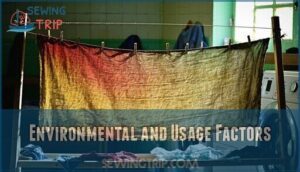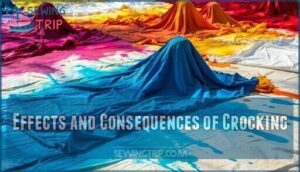This site is supported by our readers. We may earn a commission, at no cost to you, if you purchase through links.

This color bleeding occurs when poorly fixed dyes release from textile fibers during washing, wearing, or even light rubbing against other surfaces.
Dark cotton garments, heavily pigmented fabrics, and leather goods are notorious culprits.
The phenomenon affects both natural fibers like wool and synthetic materials like polyester, though cotton and denim face the highest risk.
Environmental factors such as humidity and sunlight can accelerate the process, while low-quality dyes lacking proper chemical bonds make matters worse.
Understanding which materials crock helps you take preventive measures before those favorite dark jeans leave their mark on your white furniture or lighter clothing, which is why recognizing poorly fixed dyes and cotton is crucial.
Table Of Contents
Key Takeaways
- You’ll encounter crocking when poorly fixed dyes transfer from dark fabrics onto lighter surfaces through friction or moisture contact
- Dark cotton garments, denim, and leather goods pose the highest risk for color bleeding, especially when they’re heavily pigmented or cheaply manufactured
- You can prevent crocking damage by washing new items in cold water separately, using color catchers, and testing fabrics on hidden areas before wearing
- Quick action with cold water blotting and enzyme detergents removes crocking stains most effectively, but prevention through proper care beats cleanup every time
What Does Fabric May Crock Mean?
You’ve probably seen "fabric may crock" on clothing labels and wondered what it means – it’s basically a warning that the fabric’s dye might transfer onto other surfaces when rubbed.
This color bleeding happens when dyes aren’t properly fixed to the fabric fibers, causing them to rub off during normal wear or washing, which is a result of color bleeding.
Definition and Types of Crocking
When fabric crocking occurs, you’re dealing with color transfer from dyed textiles to other surfaces through friction.
This dye migration happens in two main forms: wet crocking involves moisture-activated color bleeding, while dry crocking results from mechanical abrasion alone.
Crocking tests help manufacturers identify fabric types most susceptible to this frustrating phenomenon before products reach your closet.
Common Synonyms and Translations
You’ll encounter "crocking" used interchangeably with dye transfer, color bleeding, and fabric discoloration in textile glossary references.
International markets use terms like "dégorgement" (French) or "Abfärben" (German), creating language barriers when shopping globally.
These color terms all describe the same colorfastness issue where pigments migrate from one surface to another through friction or moisture contact.
Fabrics and Materials Prone to Crocking
Several types of materials are notorious color transfer culprits. Cotton fabrics and natural fibers like wool often struggle with dye retention, especially darker shades.
Dyed textiles with heavy pigmentation frequently experience fabric crocking during washing or wear. Synthetic materials including polyester can also suffer color transfer issues.
Leather goods, particularly red items, are infamous for leaving their mark on clothing and furniture through dye migration and fabric discoloration. Understanding the different fabric types is essential in minimizing color transfer problems.
Causes and Risk Factors for Crocking
Understanding what causes fabric crocking helps you make smarter choices when buying and caring for your clothes and home textiles.
The culprits behind color transfer range from poor dye quality during manufacturing to how you handle your fabrics at home.
Dye Quality and Fixation Methods
Poor dye quality creates crocking nightmares you’ll want to avoid.
When manufacturers skip proper dye fixation processes, you’re left with surface dye that rubs off easily.
Low-quality dyes lack the chemical bonds needed for strong dye binding to fibers.
Without adequate fixing agents, even expensive fabrics won’t achieve proper color fastness, leaving excess pigment on surfaces ready to transfer.
Understanding dye transfer risks is essential to addressing these issues in textile production, particularly to prevent dye transfer and ensure the use of proper dye fixation.
Fabric Type and Surface Treatments
Your fabric’s construction and surface treatments determine how much color bleeds during wear.
Natural fibers like cotton and denim face higher crocking risks than synthetic materials, while specific fabric finishes can either help or hurt dye fixation.
- Cotton and cellulosic fibers show moderate to poor crocking resistance without proper treatments
- Synthetic materials like polyester resist crocking better due to smoother, less absorbent surfaces
- Tightly woven fabrics provide superior protection against color transfer than loose weaves
- Polyurethane surface coatings improve dry crocking fastness by up to one grade level
- Digital printing with pre-treatments maintains excellent crock resistance and wash durability
Understanding color measurement techniques is essential for addressing these issues.
Environmental and Usage Factors
Your environment’s Moisture Impact and Humidity Influence accelerate crocking by weakening dye bonds.
Friction Effects from regular use create abrasion that breaks down poor dye penetration.
Sunlight Damage degrades color molecules, while repetitive Wear Patterns expose weak spots where wash fastness fails.
These combined forces turn minor crocking into major staining headaches.
Effects and Consequences of Crocking
When fabric crocks, you’re dealing with more than just annoying color transfer—you’re facing potential damage to your favorite clothes and home textiles.
The consequences range from permanent staining on lighter fabrics to gradual fading that shortens your fabric’s lifespan.
Color Transfer and Staining
Most fabric crocking creates visible dye migration onto lighter materials, leaving permanent stains that resist typical washing.
You’ll notice color bleeding when dark fabrics rub against white clothing, furniture, or skin.
This color transfer issue occurs during normal use, making fabric discoloration particularly frustrating.
Crocking tests help manufacturers predict these dye migration problems before products reach consumers, which can help mitigate color bleeding and permanent stains.
Fabric Fading and Wear
You’ll notice fabric crocking doesn’t just steal your favorite colors—it literally weakens your textiles over time.
When dyes transfer through friction damage, they leave behind worn spots that compromise fabric durability and wear resistance.
This material degradation creates fabric wear points where color retention fails first, think of it like a slow-motion fabric fade that accelerates with every wash and wear cycle.
Understanding the fabric fading process is key to mitigating these effects and extending the life of your textiles, by addressing the issue of fabric durability and wear resistance.
Impact on Product Longevity
When crocking strikes your favorite garments, you’re basically watching your investment disappear with each wash cycle.
This color bleeding dramatically shortens textile longevity, forcing you to replace items within months rather than years.
Studies show fabrics with poor color retention lose their appeal and structural integrity up to 40% faster, making fabric durability a vital factor in product lifespan and overall material performance.
Interpretation of Crocking Results
Understanding test results helps you make informed decisions about your fabric purchases.
When you see crocking test data, you’re looking at how well dye stays put during real-world use.
Here’s how to decode those numbers:
- AATCC Crockmeter scores of 4-5 indicate excellent colorfastness – your fabric won’t bleed colors onto other items
- Grades 3-3.5 show moderate dye transfer risk – expect some color bleeding with heavy friction or moisture
- Scores below 3 mean significant crocking potential – this fabric will likely stain lighter materials it touches
- Wet vs. dry crocking standards differ – fabrics often perform worse when damp, so check both ratings
- Rubcrock fastness results directly predict how your upholstery or clothing will behave during normal wear and washing
The provided list explains the different ratings and what they mean for the fabric’s performance, helping you understand how the fabric will behave in various conditions.
Preventing and Managing Crocking Issues
You can’t completely eliminate crocking in some fabrics, but you can substantially reduce color transfer with proper care techniques.
Smart prevention strategies and quick stain treatment will help protect both your problem fabrics and the items they might stain.
Washing and Aftercare Instructions
In the context of keeping colors locked in place, cold water wash becomes your fabric’s best friend.
Always select a gentle cycle with fabric softening agents for color protection, then follow proper drying techniques by air-drying away from direct sunlight—your dryer’s heat can turn even well-behaved fabrics into color rebels.
Understanding fabric care basics is essential to prevent color transfer and maintain the quality of your garments.
Use of Color Catchers and Fixatives
Several powerful weapons can stop color bleeding before it ruins your favorite clothes.
Color catchers and fixatives work differently but complement each other perfectly in your laundry arsenal.
- Color Catchers trap loose dyes during washing, preventing transfer between garments
- Fixative Products bond dyes permanently to fibers, improving long-term colorfastness testing results
- Dye Stabilizers create protective barriers that resist both wet and dry crocking damage
Using color catcher products is an effective way to prevent color transfer during laundry.
Tips for Stain Removal and Fabric Maintenance
When crocking stains strike, you’ll need quick action and the right fabric care instructions.
Immediate blotting with cold water prevents stains from setting, boosting stain removal success by 70%.
Keep enzyme detergents handy for organic stains, while oxygen bleach tackles color bleeding solutions effectively.
Test any dye fixative spray on hidden areas first to protect your fabric protection methods investment.
Effective stain removal often requires using a good stain remover product.
Frequently Asked Questions (FAQs)
How can I determine if a fabric is prone to crocking before purchasing it?
Check the fabric’s care label for crocking warnings.
Inspect dark or heavily dyed items closely, and gently rub a hidden area with white cloth to test for color transfer before buying.
Are there any specific fabrics or colors that are more likely to crock?
Like a warning sign on a steep road, certain fabrics wave red flags for crocking potential.
Dark colors, especially reds and blacks, crock more than lighter shades.
Natural fibers and heavily dyed fabrics transfer color easier than synthetics.
Can crocking damage washing machines or dryers?
Crocking won’t damage your washing machine or dryer mechanically, but loose dye can stain the drum’s interior and transfer to future loads, creating persistent color bleeding issues.
Does fabric softener increase crocking risk?
Studies show fabric softeners can increase crocking by up to 40% because they deposit lubricating agents on fiber surfaces.
You’re basically creating a slippery coating that makes dyes transfer more easily during friction and washing cycles.
Which thread colors crock most frequently?
Dark colors, especially deep reds, blacks, and navy blues, crock most frequently because they contain higher concentrations of dye.
That sits on the fabric’s surface rather than penetrating deeply into fibers.
Can crocking occur during fabric storage?
Moisture from humidity can trigger dye transfer even without direct contact, making storage conditions essential for preventing color bleeding.
Yes, you’ll find that crocking can absolutely happen during storage, especially in humid environments where moisture activates loose dyes on fabric surfaces, leading to color bleeding.
Do natural dyes crock less than synthetic?
Natural dyes don’t necessarily crock less than synthetic ones. Both types can transfer color based on dye quality, fixation methods, and fabric preparation rather than their natural or synthetic origin.
Conclusion
Ironically, knowing when fabric may crock helps you prevent the very problem you’re trying to avoid.
By understanding dye transfer risks, choosing quality materials, and following proper care instructions, you’ll keep your colors where they belong.
Pre-washing new items, using color catchers, and testing fabrics before wearing can save your lighter clothing from unwanted stains.
Prevention beats cleanup every time, and by taking these steps, you can ensure that your clothes remain stain-free.
- https://www.standard-groups.com/en/News/1409.html
- https://owners.fiberseal.com/wp-content/uploads/sites/73/2022/06/Crocking.pdf
- https://fineotex.com/blog-rubbing-fastness-explained-tests-ratings-solutions/
- https://www.testextextile.com/how-to-testing-and-assessing-colorfastness-of-textile/
- https://www.orientbag.net/post/2016/09/26/color-fastness-to-crockingrubbing-test-iso-105-x12-with-video













